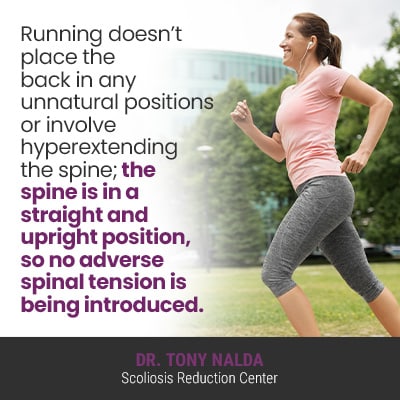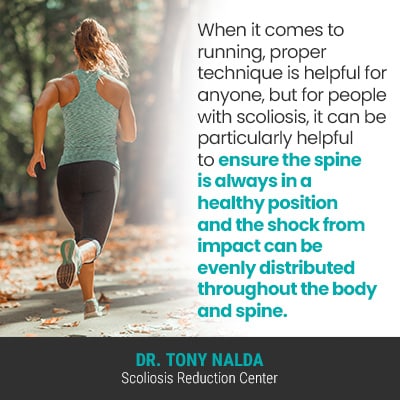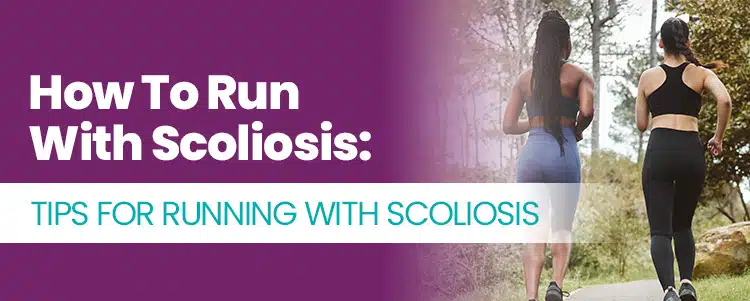There was a time when a diagnosis of scoliosis was thought to mean an inactive life of limitations; fortunately, with how much we’ve learned about the condition over the years, we now know that’s not the case, at least it doesn’t have to be. When scoliosis is detected and treated early, people can still thrive, despite having an unnaturally-curved spine. Continue reading to learn if running is a scoliosis-friendly activity.
Activity restrictions are case-specific; what’s safe for one patient might not be considered safe for another. Repeated jarring impact from running can further compress a scoliotic spine, which is why short-distance running/sprinting is generally considered safer than long-distance running.
Before getting to specific tips for running with scoliosis, let’s talk about why it’s so important for scoliosis patients to stay physically fit and active.
Exercise and Scoliosis
As mentioned, scoliosis was once thought to be a debilitating condition, but that was before we fully understood how scoliosis affects the body and responds to treatment.
Being diagnosed with scoliosis means an unnatural sideways spinal curve that also twists has developed, and this means the body is being exposed to uneven forces.
The main effect of scoliosis in children is postural deviation, and in adults, it’s pain, and as a progressive condition, scoliosis has it in its nature to worsen over time.
Scoliosis disrupts the body’s overall symmetry and shifts its center of gravity, so it also causes disruptions to balance, coordination, and gait, which is why it’s natural to assume running might be too difficult, painful, or unsafe for people with scoliosis, but that’s not generally the case.
While it’s important for everyone to stay physically fit and active, for people with scoliosis, this is especially important; the spine needs to stay strong and flexible, and a person’s core strength is key because the muscles that surround the spine are responsible for supporting it.
If the muscles surrounding the spine are weak and/or unbalanced, it can be difficult for the spine to maintain its natural curves and alignment, so this is another reason to stay strong, fit, and healthy: it can equal more spinal support.
Progression makes the spine more rigid, which makes it less responsive to treatment, so exercise that keeps the spine as loose and flexible as possible can mean a spine that’s going to be more responsive to chiropractic care.
Exercise is also important because it keeps the body healthy in general, which helps to create an internal environment that’s conducive to healing.
Exercise is also associated with mental-health benefits, and when it comes to the rigors of scoliosis treatment, a healthy mindset can go a long way, and the endorphin-increase from exercise can be a healthy way to cope with the challenge of living with a progressive spinal condition.
Now that we know the general ways in which exercise can help people with scoliosis, let’s talk specifically about running.
Running with Scoliosis
Not all exercise and activities are safe for people with scoliosis, but each case is different.
Scoliosis doesn’t just range from mild to moderate and severe to very severe, there are also different condition types a person can develop, with different causes, symptoms, and treatment needs.
So no form of exercise or activity should be attempted without a patient first clearing it with their scoliosis treatment provider, and this is because some activities should be avoided by people with scoliosis, while some should be approached with caution and modified, and others are generally considered safe.

When it comes to scoliosis and exercise, generally, exercises that work the body symmetrically, don’t put the back in any unnatural positions, or introduce compression from repeated jarring motions or impact are considered safe.
Activities and exercises that overuse one side of the body can exacerbate the condition’s asymmetrical effects, one of which is a muscle imbalance, putting the back in an unnatural position or hyperextending the spine can put added stress on its vertebrae and discs, and repeated jarring motions and impact can introduce compression to an already-compressive condition (adult scoliosis).
But what about running? What does running do?
Running works the body’s muscles symmetrically, so muscles on either side of the spine are worked evenly, and running is known to help people maintain a healthy weight, which is also good for the spine and its parts as carrying excess weight means more pressure on the spinal joints and discs.
Running doesn’t place the back in any unnatural positions or involve hyperextending the spine; the spine is in a straight and upright position, so no adverse spinal tension is being introduced.
Running is also good for bone health, and as scoliosis is a structural condition involving the bones of the spine, maintaining bone health is beneficial, especially for females who are more vulnerable to changes in bone density due to menopause.
When it comes to the downside of running with scoliosis, it can be the repeated jarring motion and related compression of the feet hitting the ground repeatedly, which over time, and long distances, can introduce some compression, but again, this is more likely to affect severe cases and in cases of long-distance running.
In addition, the benefits of running and staying physically fit, maintaining core strength, spinal strength and flexibility can help with treatment and leading a scoliosis-friendly lifestyle.
Now that we know how running is good for people with scoliosis in general, let’s discuss some specific tips for how to cultivate a good running technique.
Running Technique and Scoliosis
When it comes to running, proper technique is helpful for anyone, but for people with scoliosis, it can be particularly helpful to ensure the spine is always in a healthy position and the shock from impact can be evenly distributed throughout the body and spine.

Keeping the head up and looking ahead is important; this ensures the cervical spine is aligned with the other sections; looking down only increases the weight of the head on the neck, straining the cervical vertebrae.
Keep the body relaxed and arms/hands around hip/waste height; holding them up too high just takes more energy to maintain, and landing midfoot, instead of on the toes or heals is also important; this spreads the stress from impact up through the center of the foot, rather than up through the front or back of the body.
Most importantly, be aware of posture; keeping the body straight and aligned means the neck is straight and upright above the thoracic spine, and the thoracic spine is straight above the lumbar spine, and this means the entire spine is being held in a neutral and aligned position as it was designed to be.
As mentioned earlier, the only instance in which running can be bad for scoliosis is if particularly severe, poor running form is an issue, and/or if the running is long distance as the repeated shock from the feet hitting the ground does jar the spine; however, in most cases, the benefits outweigh the risks, and unless severe and told it’s not appropriate by a patient’s treatment provider, running shorter distances can also help minimize potential risks.
And before any type of exercise, it’s always good to warm up and gently stretch the body and muscles as this can help reduce the risk of injury.
Conclusion
So for those asking should I run with scoliosis, the key is to be aware of form and technique, and when possible, particularly if running is causing back pain, running for shorter distances can help.
A potential negative to running can be the repeated shocks and jarring motion of when the feet hit the ground, but running with good technique also minimizes that compressive force, and this is also more likely to affect patients with severe to very-severe scoliosis who are running long distances.
Practicing good form means landing midfoot, instead of on the toes or heel as this doesn’t evenly distribute the impact throughout the middle of the body, where it’s strongest and can absorb/distribute it evenly, instead directing it more up the front or back of the body.
Keeping the head upwards and facing forward, rather than looking down, means the cervical spine is aligned with the thoracic spine, and the middle/upper back is aligned with the lumbar spine, and the neck isn’t being exposed to added weight from bending the head forward and/or down.
Here at the Scoliosis Reduction Center®, part of my treatment is providing lifestyle guidance and tips on how to lead a scoliosis-friendly lifestyle, and as I value the place of exercise in treatment and daily life, helping patients find a balance of healthy scoliosis-friendly activities is key.
When it comes to running, I help patients understand its pros, potential cons, and the importance of proper posture and technique.
Running can be great for people with scoliosis because it keeps them fit and active, is a great cardiovascular activity, helps maintain a healthy weight and level of flexibility, works the body’s muscles symmetrically, including the back muscles that support the spine, and all of these factors make the body and spine more responsive to treatment.




